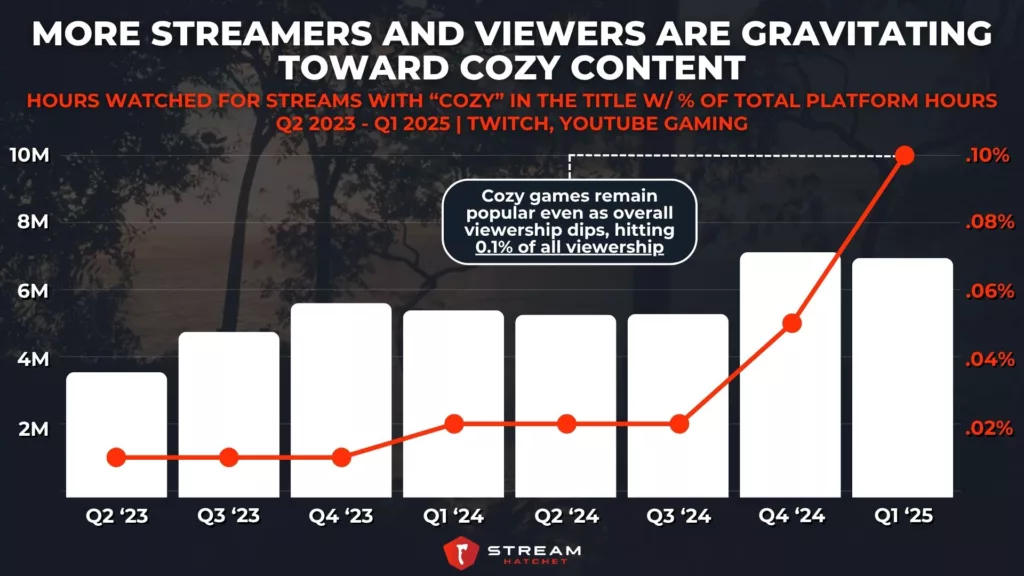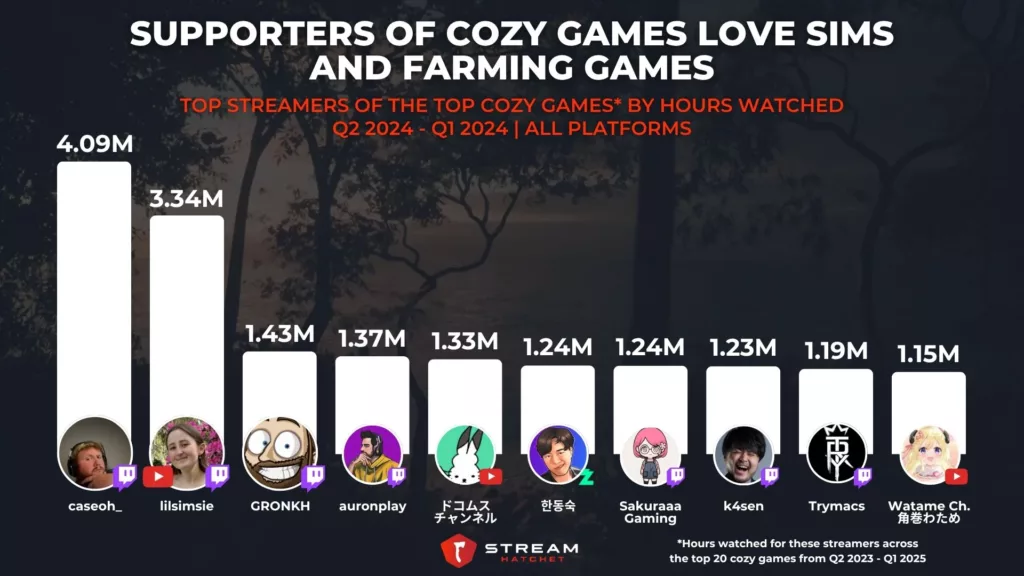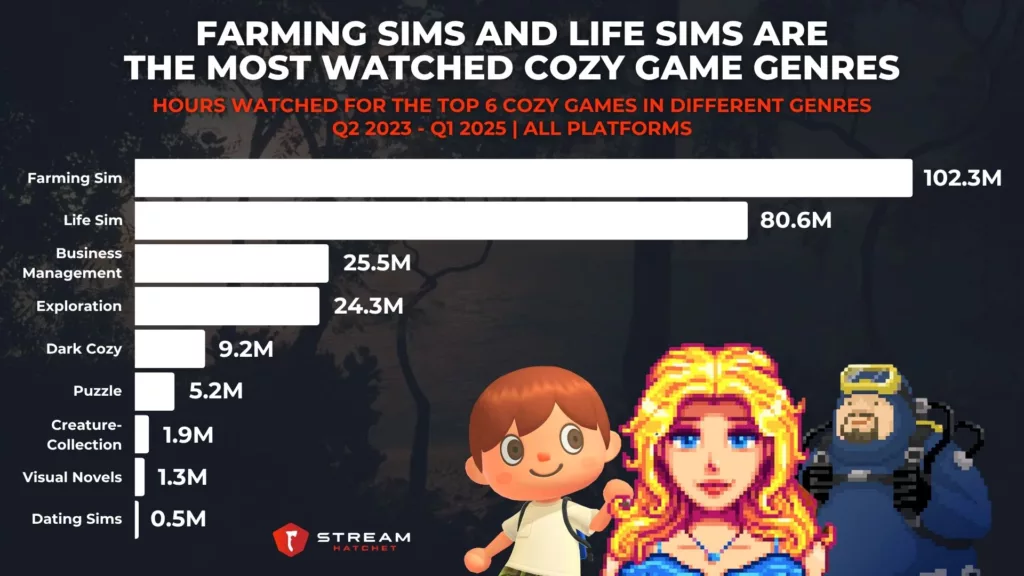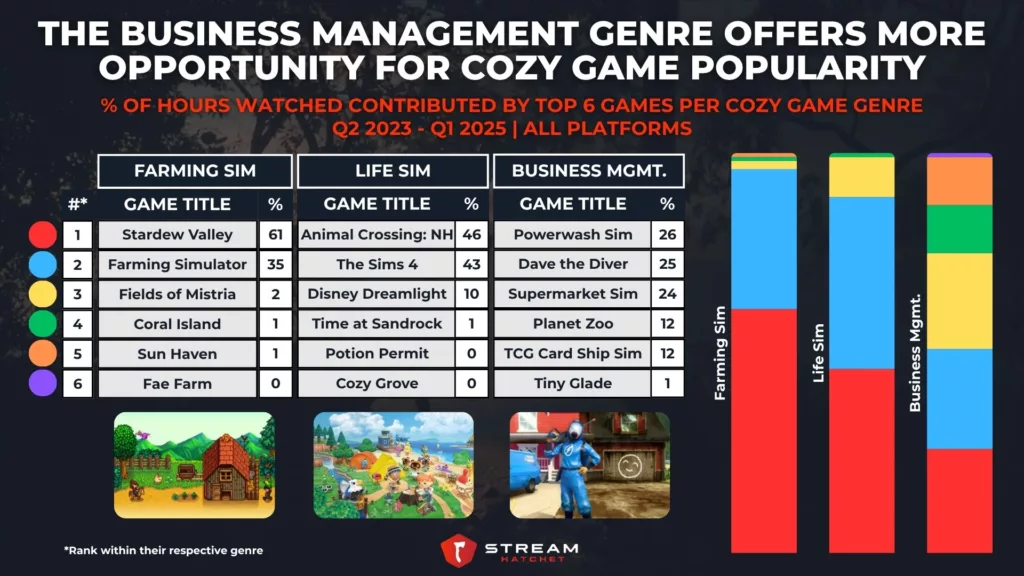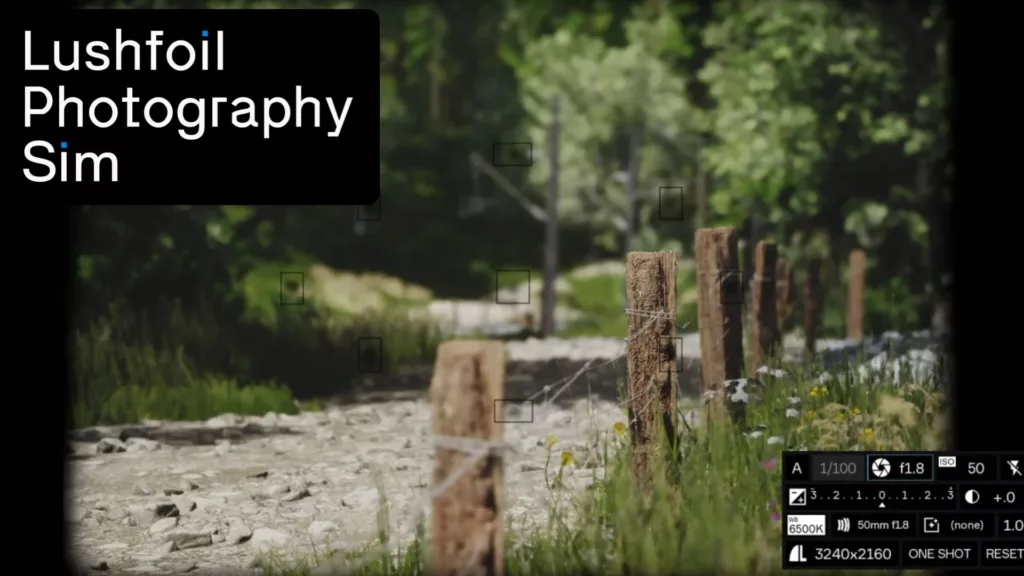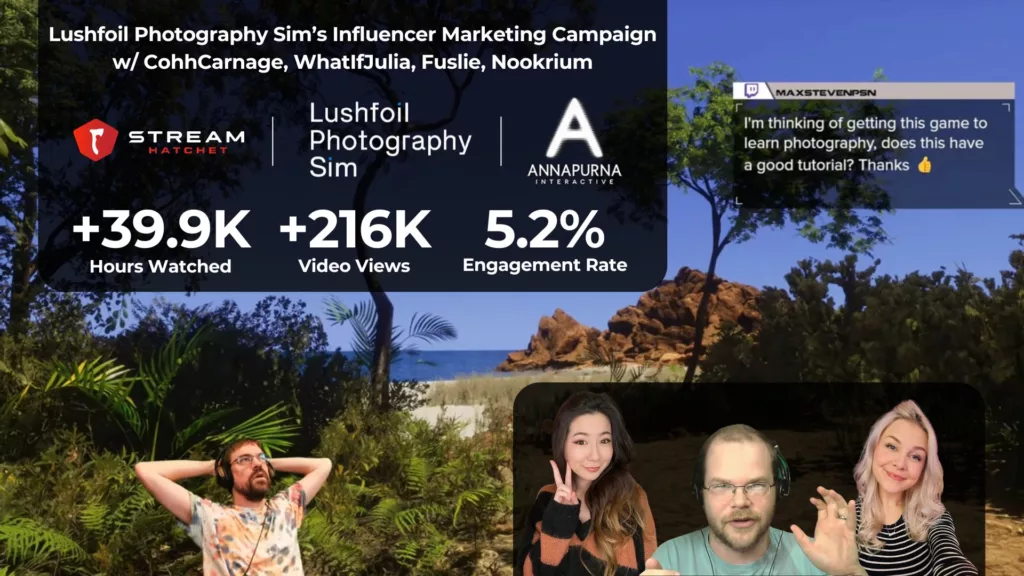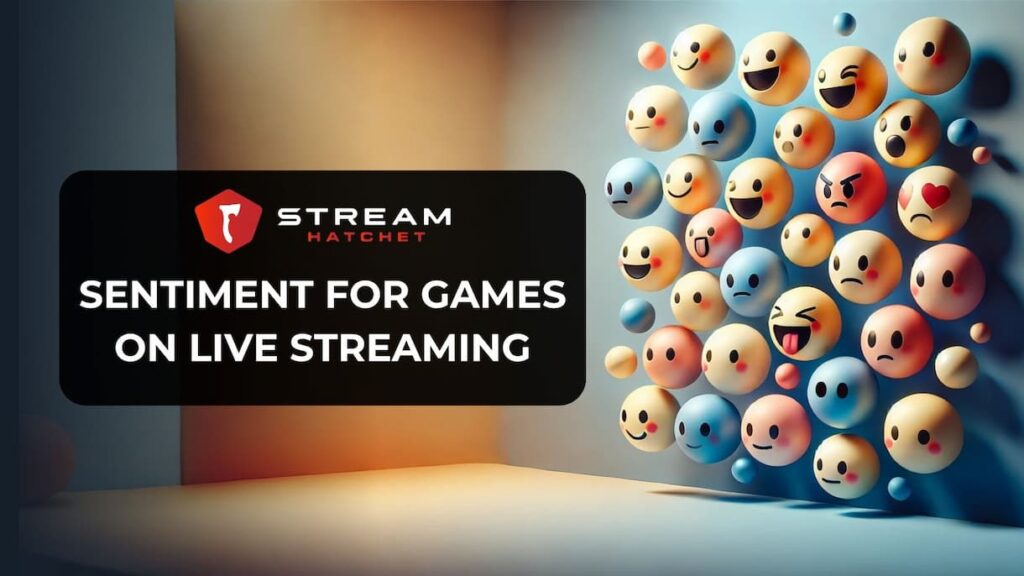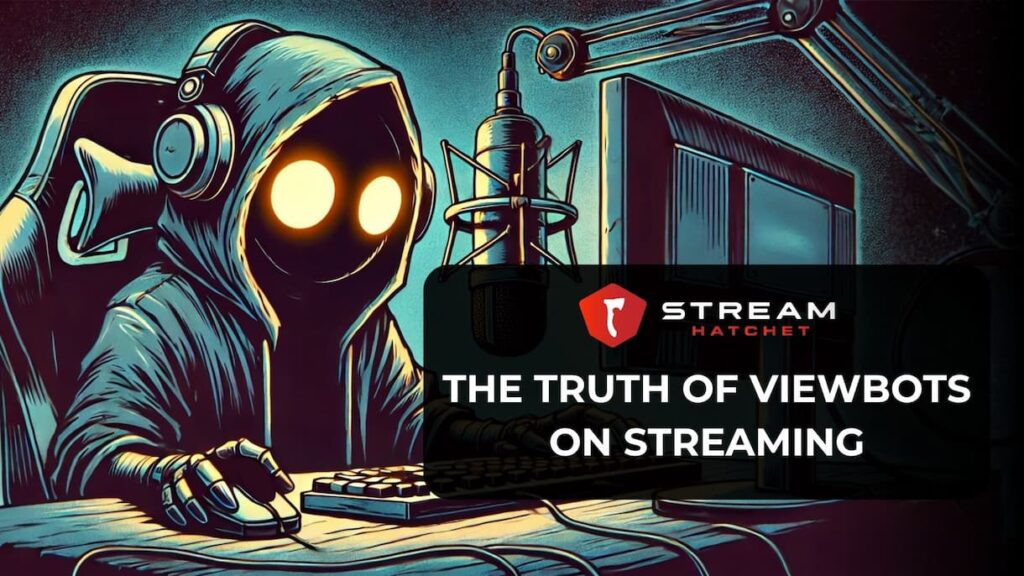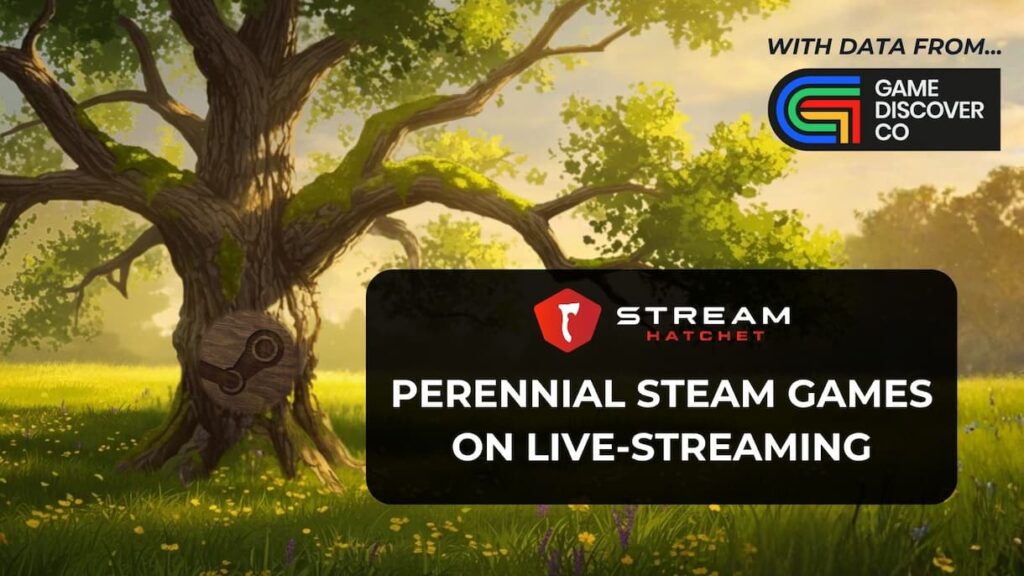Cozy games experienced a massive explosion in popularity during the pandemic, leading to a widely acknowledged wave of new players seeking comfort in gaming. The reason? Disconnection, decompression, and a sense of control. Research firm Sago states that over 50% of people play these games to switch off from everyday anxiety (and they’ve got lots more awesome cozy game data you should check out). This alternate game design philosophy has attracted more female players than ever before, and these peaceful goals are conducive to family-friendly experiences – But do these new players seek out community on live-streaming platforms?
One major difficulty here is defining the cozy game genre and its community. Reuters has an excellent browser-based minigame summarizing common elements among cozy games: Pastel colour palettes, serene soundtracks, cute characters, and easily understood gameplay loops typically set in pastoral settings (see: Cottagecore). Games like this have existed since at least the late 90’s, including The Sims, Harvest Moon, and later titles like Nintendogs. But the new wave of “cozy” games is mostly marketing spin that kicked off with the campaign for Spiritfarer in 2019: “Cozy” became an easy handle for audiences to find games that aren’t centered on action. For our discussions here, we’ll be defining cozy games using the elements listed above combined with how these games position themselves in their marketing.
Cozy Games Gaining Loyal Followings on Live Streaming
Cozy games are growing in popularity on live streaming. Over the past two years, the quarterly hours watched for streams containing the word “cozy” on Twitch and YouTube Gaming have nearly doubled from 3.6M to 7M hours watched. This growth is occurring even relative to the overall jump in demand for live streaming, with the proportion of total hours watched made up by cozy games seeing a 10-fold increase over the same time period.
Largely this is due to more streamers covering cozy games: The biggest jump was from Q3 to Q4 of 2024 when the number of streamers using “cozy” in their stream titles jumped from 7K to 9.1K. All of this growth matches with more players gravitating towards cozy games since the pandemic, and more cozy games being released (a delayed effect as publishers are now releasing their own titles to capitalize on the boom).
Among those streamers propping up cozy games over the last 12 months are a mix of big names and niche streamers. Caseoh_ is back again, who we already know is a big supporter of indie games, with 4.1M hours watched across the top 20 cozy games. Caseoh_ tends to cover most new indie games when they come out, bringing his endearing personality and massive following to these titles. Representing the other approach we have lilsimsie with 3.3M hours watched, mostly generated from her dedicated The Sims 4 content. Among the other streamers in the top 10, there’s a strong Japanese presence thanks largely to Animal Crossing: New Horizons. However, Japanese streamers (particularly VTubers) also tend to try out new Simulator Games, many of which have a cozy vibe.
The Most Popular Cozy Game Genres
Since “cozy games” is a fairly broad label to investigate, we decided to get a better handle on which cozy game genres perform well by bucketing them into concrete gameplay categories. For each of these categories, we’ve then added up the top 6 games to see their overall viewership on live streaming (since beyond the top 6, viewership is minimal).
Simulators of all kinds have dominated the most popular cozy game genres over the past two years by hours watched, including Farming Sims (102.3M), Life Sims (80.6M), and Business Management Sims (25.5M). Scanning further down the list we have Exploration games bringing in 24.3M hours watched – but a massive 21.9M of these hours are brought in by Palia alone. Less popular cozy game genres on live streaming include Visual Novels (perhaps being too passive) and Creature Collection Games (we’ve obviously excluded Pokémon games from our cozy definition). Notably, the biggest genres on live streaming lack cozy alternatives (Shooters, MOBAs, Battle Royales), with their design philosophies centring on creating spectacle through action-packed gameplay – clearly preferred viewing for most audiences online.
Zooming in on those top three genres, we see that Farming Sims and Life Sims are mainly propped up by two titles each that contribute 96% and 89% of all viewership, respectively. For Farming Sims, that’s Stardew Valley and Farming Simulator (all editions combined), while for Life Sims that’s Animal Crossing: New Horizons and The Sims 4. This is a massive issue for indie developers looking to make games in this space: Those genres seem in-demand, but the actual audience attention available to scoop up is very minimal which kills game discovery opportunities.
Business management games, on the other hand, have a far more even spread of viewership, with different Simulators being able to find equal audiences including Powerwash Simulator (26%), Supermarket Simulator (24%), and TCG Card Shop Simulator (12%). It seems that Simulator fans are always looking for a new role to try on, and that productivity in games is a great drawcard for live-streaming viewers craving order and organization. Many of these games are also from new IPs as opposed to the other genres that lean on pre-existing franchises and can simply reactivate their core audience.
Influencer Marketing Campaigns for Cozy Games: Lushfoil Photography Sim
For cozy games looking to break into the space, then, there seem to be more opportunities for Simulator games with unique hooks to attract new audiences. This may partly explain the recent success of Lushfoil Photography Sim: A detailed photography sim where players can explore photorealistic versions of scenic locations from the real world, all without inclement weather and bustling tourists obstructing their views. Developed by Australian solo dev Matt Newell and published by Annapurna Interactive, Lushfoil Photography Sim offers itself as a “tranquil” experience that capitalizes on those cozy game themes of reducing stress and meditation through repetition.
Of course being an indie, cozy game without the typical cozy game aesthetic poses an issue: How do you actually get people to notice you? Firstly, by being published by a trusted publisher like Annapurna Interactive. Secondly, Annapurna Interactive reached out to our team at Stream Hatchet to run a dedicated influencer marketing campaign to get the word out about developer Matt Newell’s intricately recreated real-life landscapes.
Leveraging our contacts within the industry, Stream Hatchet asked four key streamers to try their hand at the game – creators known for passionately promoting niche games that otherwise wouldn’t reach mainstream audiences. CohhCarnage, WhatIfJulia, Fuslie, and Nookrium hosted streams previewing the first few levels of Lushfoil Photography Sim and shared game-related content via their social media channels. Matt Newell also joined them on stream to discuss the game’s development and provide a peek behind the scenes of what makes a photorealistic game tick.
The results speak for themselves: Over ⅓ of Lushfoil Photography Sim’s live-streaming reach came from these four creators, generating just shy of 40K hours watched. Fans were also actively chatting with these influencers, hitting an average engagement rate of 5.2% across their streams. In total, all of this amounted to 216K video views: A huge boost to a game that had no prior IP and exists outside of typical genre conventions. Pictured above, commenters realized the potential for the game as a low-cost way to try their hand at photography, leaving a wholesome impression of the title and its developer.
_
As seen in the Lushfoil Photography Sim influencer marketing campaign, a game doesn’t need to feature the stereotypical tropes of a cozy game to capture that audience. There’s no soft pastels, no fantasy landscapes – just serene environments in which to explore and space out. In fact, forcing the traditional “cozy” aesthetic onto people may hurt a game’s chances of standing out from the crowd or risk triggering that “burnout” feeling.
However, working within the emerging cozy genre’s conventions does make it simpler to market your game as such. Whole communities have popped up to support these types of games, like Wholesome Games, which runs an annual showcase for all sorts of peaceful, family-friendly titles. With the community thriving and much-anticipated cozy games like Witchbrook on the horizon, indie developers should consider how to tap into influencers who support the cozy game philosophy.
To learn more about effective influencer marketing strategies, download Stream Hatchet & Sideqik’s Influencer Marketing eBook:


